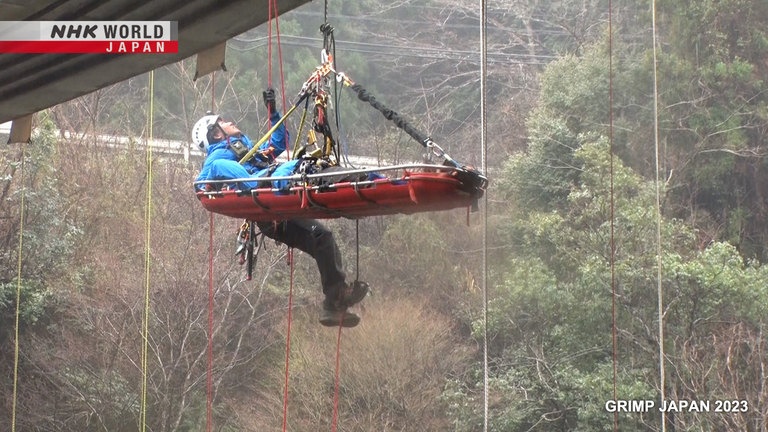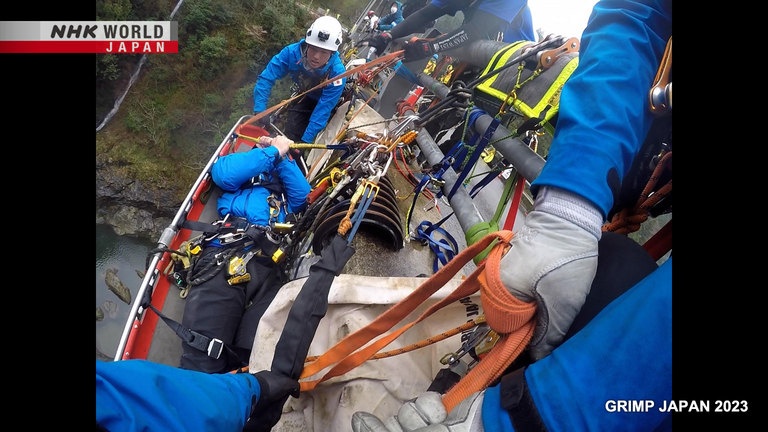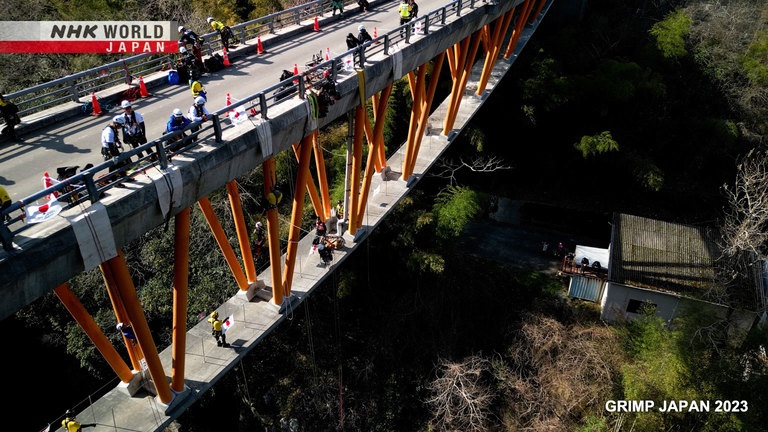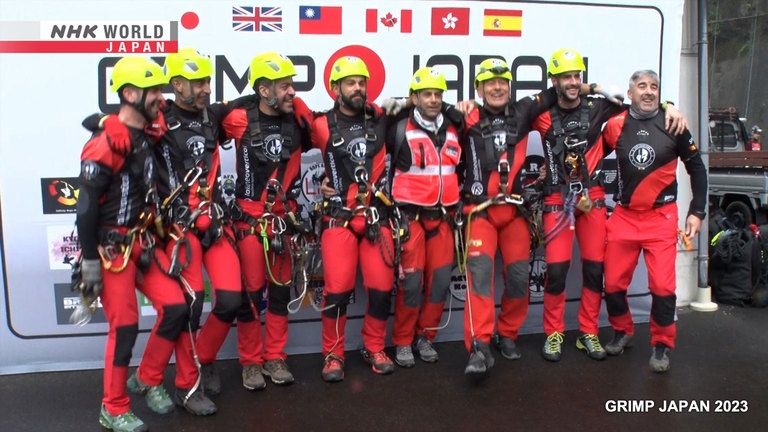Rope Rescue Expert - Hayashida Akihiro
Rope rescue is an emergency practice that deftly deploys cords, clasps and pulleys to reach individuals stranded on hillsides and cliffs, or amid floods, rubble, and in other locations that helicopters and emergency vehicles struggle to reach. Hayashida Akihiro leads a fire service rope rescue team that, in 2022, won first prize at a global rope skills tournament in Belgium. We follow his efforts to promote these lifesaving techniques to rescue services across Japan.




Transcript
"FRONTRUNNERS"
Our techniques have to keep evolving.
Floods and explosions. An awful combo.
We're eternally indebted to him.
Don't worry. We'll get you out of here.
Rope rescue expert
Hayashida Akihiro
Minami Kyushu, Kagoshima Prefecture.
Today, this local dam is the site of a disaster response drill.
And leading the rescue team is Hayashida Akihiro.
The drill is, there's a worker stuck under the bridge.
He's conscious and can walk.
We have to get him onto a stretcher and back up to safety.
Their first task is to rescue this stranded worker.
Rope rescue is a school of disaster response
that aims to reach locations inaccessible by ambulance or helicopter.
Black here. Then white, then yellow.
OK, now for the highline.
Now for the stretcher.
- Which way?
- Lengthways.
Rescuers, this is your cue.
It takes 14 minutes to reach the rescue subject with the stretcher.
Keep that rope straight.
The rope operators hoist the stretcher up.
Nearly. A little more...
Stop!
Make sure the rope isn't snagged.
Here goes: One, two, three!
Having reached the strandee,
it takes only four and a half minutes longer to get him back to the top.
In 2022, Hayashida led this team
at an international rope rescue contest in Belgium...
where they beat off stiff opposition
from 23 other teams to claim first prize.
And today, fire personnel from across Japan
are here to observe the world's best in action.
To get the stretcher back safely, you have to focus on the victim.
But if conditions aren't right, you need to step back.
Things can change quickly, so you must be ready for that.
The chance to learn from Hayashida-san brought me all the way from Okinawa.
You can see they're world class.
I'm here today because I want to improve my knowhow and skills to become a rescuer.
We're responding to more emergencies in all kinds of settings,
so we have to respond to that diversity by updating our own techniques.
But I know we always have to keep evolving.
Hayashida Akihiro is based in Soja, Okayama Prefecture, western Japan,
at the headquarters of the local fire department.
He is a 25-year veteran of the service.
And it was in 2004 that he first became acquainted with rope rescue.
When I first joined the fire service,
rope rescue wasn't a concept we dealt with.
I think I first encountered the term in a magazine or something.
I was intrigued, and I tried to find out more.
I took part in workshops to experience it for myself,
and it was a real culture shock.
Instead of hoisting up victims with the combined strength of dozens of crew,
it was about working efficiently, with pulleys and ropes.
On a national scale, our fire department in Soja is quite small,
so I sensed real potential.
In 2016, his years of hard work earned Hayashida the opportunity
to join a Japanese team at an international rescue contest in Taiwan.
Results-wise, we finished near the bottom.
Our skills were behind and we were much slower.
It was a bitter pill to swallow.
At these tournaments, you're presented with a surprise scenario in an unfamiliar location
and have to respond accordingly,
which is a lot like a real rescue situation.
I thought sticking with it could help transform rope rescue in Japan.
That early disappointment spurred his pursuit of technical excellence.
Three years ago, he opened a dedicated rope rescue gym.
This is where we develop our skills.
Previously, we didn't really have anywhere to practice these techniques.
Hayashida's team, "Japan West 9PM"
draws together fire personnel from nine neighboring prefectures,
with members helping to fund this facility out of their own pockets.
It may not look like much,
but it's where we honed the skills to compete on the world stage.
The basic principles of rope rescue are actually pretty simple.
Lowering, hoisting...
The basic maneuvers are pretty constant,
so here we can cover most of the fundamentals.
Let's try that again.
Hayashida is particularly meticulous
when it comes to raising and lowering the stretcher.
When you send up the stretcher, it can tend to lean inwards, which tilts the victim up too.
It's important to keep things level.
It's all a sign of his focus on the needs of potentially injured rescuees.
You have to consider things from the rescuee's perspective.
It's important to pay particular attention to their head.
In the suburbs of Soja, lies the Shimobara district.
Long time no see!
Thank you for coming.
Hayashida is here to revisit the site of a dramatic past rescue.
In 2018, record-breaking rainfall across western Japan
caused flooding of multiple rivers.
In Okayama alone, over 8,000 homes were badly damaged or destroyed.
During the floods, we made roundtrip after roundtrip by boat
to evacuate residents who had been left stranded.
Our rope rescue techniques were vital.
In Shimobara, the flooding also triggered a steam explosion at a local aluminum plant.
The blast unleashed a hail of metal debris
that caused widespread damage to surrounding buildings.
It took the tiles off this roof, didn't it?
And the shutters were all smashed in.
We put a tarp over this house too.
Hayashida called in fire service teams from across Japan,
who used rope rescue techniques to scale some 90 local homes
and cover them with tarpaulin to prevent further rain damage.
That helped protect all our clothes and other possessions from water damage.
- It was such a massive relief.
- Just to have them here.
We're just so grateful.
I well up just thinking about it.
We're eternally indebted to him.
February 2023, in Miyoshi, Tokushima Prefecture,
on the banks of the Yoshino River.
We find Hayashida and his colleagues kitted out in their rescue gear.
We could start down there, or up here.
But this is closer, and it's a downward trajectory,
so this is probably the best choice.
In March, we're set to host a global rope rescue contest here.
We want to use the whole town as a setting for competition between teams from around the world,
so we're here today to plan things out.
As head of the organizing committee for Japan's first ever major rope rescue contest,
Hayashida is here to scout potential locations.
They plan to incorporate terrain and structures across the town.
The plan is to leverage local features like this bridge for rescue scenarios
based on real world emergencies in an authentic setting.
It's about 50 meters down to the river.
When you're tackling heights you're not used to it can be nerve wracking.
It's totally different.
Though there's still a month to go until the contest,
preparations are already underway at the venue for the opening ceremony.
We want people to feel excited, don't we?
They need to feel impressed when they walk in.
Interacting with fire personnel from overseas
is a great chance to exchange techniques in a way that helps everybody grow.
Hosting this here in Japan can give a big boost to domestic rope rescue.
The following week...
(February 19, 2023)
And Hayashida joins his team as they prepare for the contest.
For next month's event, he has appointed young colleague, Shinmyo Daisuke,
as leader of Japan West 9PM.
Today they're practicing how to rescue the victim of a fall.
The aim is to lower a stretcher from the second floor
to rescue a subject posing as having fallen to the ground below.
OK... Go!
Hold it there.
You have to keep talking.
Give updates. How much further?
A lack of direction from Shinmyo
left the team unsure of the stretcher's bearings.
When they're bringing the stretcher up, you have to give instructions.
If the leader is silent, the team loses cohesion.
Don't get wrapped up in helping out.
Give guidance with a word here or a glance there.
You know all this stuff.
I'm new to this role, so I don't have full control of the team yet.
I still have a lot of uncertainties, so I need to improve.
(Takamatsu, Kagawa Pref.)
A month into his role as team leader,
we join Shinmyo at home with his family.
Here comes the fire team!
Let's train!
To help prepare for the contest,
he reviews film from Hayashida's time as leader.
It's almost like he's got eyes in the back of his head.
If we start to lose focus, he's on us right away, like "sharpen up."
As a fire fighter you hone all these skills for emergencies
that may arrive at any time.
You may never need to use them, and in fact, you don't really want to.
But to keep working on those skills is part of our job.
So fundamentally, the most important thing is "passion," or rather "commitment."
I feel Shinmyo-san has that.
So I'm sure he can become a really great leader.
The day before the contest.
She's off to college in spring. In Hiroshima.
Hello there. Nice to meet you.
And Hayashida is getting some help with his final preparations from daughter, Sawa.
I think it's amazing to dedicate yourself so firmly to one thing.
Because Dad has always worked hard for others,
I feel I'd like to do a job that benefits people, too.
- See you.
- Right, shall we head off?
Best of luck for today.
I've been taking stomach pills all week.
I'm not competing, but I need it all to go smoothly.
It's a lot of pressure.
Back in Miyoshi.
The tournament welcomes 24 teams, some 170 participants in total,
from six countries around the world
including 19 teams representing Japan.
Welcome to Grimp Japan!
This event is not just a contest.
It's about sharing techniques and knowhow
to help every one of us to provide victims with safe, reliable,
top class rescue in times of need.
This occasion is all about promoting technical excellence.
Let's take the next stage in Grimp Japan!
The teams will tackle ten scenarios in a combination of natural and urban settings,
all painstakingly planned by Hayashida.
At the bridge we saw earlier, the contest is underway.
Shinmyo and the Japan West 9PM team
are working to rescue a subject stranded at the end of a climbing rope.
Here goes!
Shinmyo has the route meticulously planned out.
OK, stop!
Stay calm.
All lift together.
And following Hayashida's advice,
he makes sure to give constant instructions.
Judges award marks on criteria including safe execution, teamwork, and speed.
Your teamwork was great,
but the reascent took a while,
so the guys holding the rope looked exhausted.
We overcomplicated things.
I need to take a more flexible approach.
The next challenge takes place on the steel foundations of this building
set on a steep incline.
Here too, they have to rescue a subject suspended by a rope.
Keep the white and black ropes tight!
I've reached the subject.
Having quickly reached the rescuee, they wait for the stretcher to arrive...
but it's taking longer than expected.
Hayashida watches on from the ground.
Three of them all just hanging there.
They need to plan things out, not just race to the victim.
They got there quickly but the rescue can't start without a stretcher.
In the end, the rescue takes 46 minutes to complete.
And that marks the halfway point of the competition.
Leading the board is a team from Hyogo Prefecture.
While in second place are the runners up from last year's tournament in Belgium.
But Japan West 9PM remain within touching distance in third.
- How's it going?
- These scenarios are tough.
Tough? Nonsense!
We're completing the tasks, but there's lots of room for improvement.
If you don't keep things simple, they start to get complicated.
Keep your chin up.
Time for the team's final test.
Rescuing a subject who has fallen from a cliff.
They have to take care that their ropes don't fray and break on the jagged rock face.
Shinmyo begins by surveying the terrain.
We'll take the stretcher over this boulder.
Nice and smooth over the top.
Lay a rope protector in this groove down the middle.
Then it's straight down to the bottom.
Shinmyo's chosen route starts from a large boulder
but is relatively obstacle free.
In case of spinal injuries, they fit the subject with a neck brace.
And while most of the other teams decide to pull the stretcher back up lengthways...
Shinmyo decides to keep things perpendicular.
Don't worry. We'll get you out of here.
Slow down. It's a rocky surface, so take it slowly.
Ready? One, two, three!
- Did you come up sideways?
- We did.
That's a bold move.
Here, it would've been easier to do it lengthways,
but it's more comfortable for the victim to keep them flat.
Our role is to protect the rescuee, so we took the extra effort.
The final challenge saw Shinmyo
showcase the victim-focused approach he inherited from Hayashida.
I think we did OK.
(March 19, 2023)
Time for the prize-giving ceremony!
Are you nervous?
In third place:
Espeleosocorro Sin Fronteras!
In third place is a Spanish team
who displayed great speed in the final few events.
In second place:
Japan West 9PM!
A strong performance down the stretch saw Shinmyo and his team
climb up the rankings to take second place.
I'm disappointed we couldn't come first,
but we're glad to have been a part of such a memorable tournament.
Thank you all very much.
And the champions are:
NR Japan!
In first place is the team from Hyogo.
The path we are on has no final endpoint.
It's about constant evolution.
It's about working every day
to take rope rescue capabilities in Japan to the next stage,
and help each other to improve, together.
- You go!
- We go!
Thanks for your hard work.
What is it that motivates Hayashida Akihiro?
Helping people in need and providing people in Japan
with the rope rescue skills needed in an emergency.
That's the end goal for fire personnel like us.
Keeping up our activities and improving our skills
because one day they'll definitely be required.